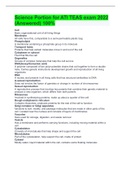Exam (elaborations)
Science Portion for ATI TEAS exam 2022 (Answered) 100%
- Course
- Institution
Science Portion for ATI TEAS exam 2022 (Answered) 100% Cell Basic organizational unit of all living things Membrane All cells have this, comparable to a semi-permeable plastic bag Phospholipid A membrane containing a phosphate group in its molecule Transport holes Proteins that help certa...
[Show more]



